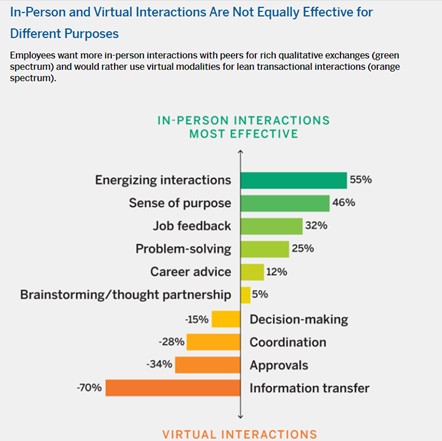Why we need to stop believing that culture and collaboration sit within the four walls of an office.
Recent research finds that more than three-quarters of C-suite executives expect the typical “core” employee to be back in the office three or more days a week. The reason? While they recognize that the great work-from-home experiment was surprisingly effective they also believe that it hurt organizational culture and belonging and that it does not support collaboration and innovation.
A growing body of research debunks these beliefs.
Challenging Biases
Through his work, Gleb Tsipursky, CEO of the future-proofing consultancy Disaster Avoidance Experts, and author of Returning to the Office and Leading Hybrid and Remote Teams: A Manual on Benchmarking to Best Practices for Competitive Advantage, has identified several cognitive biases, or mental blind spots, that influence leader decision-making around where and how people should work. Tsipursky cautions that these biases are causing leaders to “fall victim to mental oversight,” and “doing what they feel comfortable with, even if it devastates employee morale, engagement, and productivity; seriously undercuts retention and recruitment; and harms diversity and inclusion. In the end, their behavior is a major threat to the bottom line.”
Rob Cross, Edward A. Madden Professor of Global Leadership at Babson College, and Peter Gray, Professor at the McIntire School of Commerce at the University of Virginia, also caution decision-making based on “intuition”: “You don’t have to look far to find examples of companies advocating for policies fueled by a desire to get back to ‘seeing people,’ or the blanket belief that engagement or innovation is suffering in virtual settings. But such approaches don’t optimize business performance, innovation, or engagement, because they are blind to the informal networks through which collaborative work happens.”
To put in place a model that optimizes business performance, innovation, and engagement, Cross and Gray suggest leaders take a data-driven approach and identify where and how collaborative work happens through organizational network analysis (ONA), a methodology that maps employees’ working relationships and can help leaders understand which connections among employees should ideally happen in person and which ones can occur virtually.

Source: Optimizing Return-to-Office Strategies With Organizational Network Analysis, Sloan Management Review.
Challenging biases, Cross and Gray’s research shows that information sharing, project coordination, and decision-making are effective when done remotely, while in-person interactions are best used for development growth or to generate energy.
Collaboration; how, not where
Research by Ethan S. Bernstein, Professor at Harvard Business School, and Ben Waber, president and co-founder of Humanyze, found that face-to-face interactions dropped by roughly 70% after the firms transitioned to open offices, while electronic interactions increased to compensate. As for the argument that chance meetings in the office will spur collaboration and innovation, Bernstein isn’t so sure: “There’s credibility behind the argument that if you put people in spaces where they are likely to collide with one another, they are likely to have a conversation. But is that conversation likely to be helpful for innovation, creativity, useful at all for what an organization hopes people would talk about? There, there is almost no data whatsoever. All of this suggests to me that the idea of random serendipity being productive is more fairy tale than reality.”
In short, collaboration is about how people communicate and engage with one another – not where.
Not convinced? Consider the creativity and innovations organizations have realized since the start of the pandemic – when people were working remotely.
Cultivating Culture
An organization’s culture is not a policy, nor can it be achieved through a top-down mandate. Rather, an organization’s culture “lives in the collective hearts and habits of people and their shared perception of ‘how things are done around here.’ Someone with authority can demand compliance, but they can’t dictate optimism, trust, conviction, or creativity.”
We need to get rid of the notion that culture sits within the four walls, and instead focus on cultivating an effective culture. What is an effective culture? One that is both strategically relevant, because it prioritizes the behaviors essential to the success of your business, and strong, in the sense that employees trust that it is real and value it. Such cultures help companies attract and retain great people and contribute to fantastic bottom-line performance. The key here, say Professors Jenny Chatman and Francesca Gino, is cultural adaptability, or your organization’s ability to innovate, experiment, and quickly take advantage of new opportunities.
As Mark Perna, Author, Speaker, and CEO, puts it: “If we’ve learned anything from 2020, it’s that culture is not contained in a physical location. Rather, culture is nurtured within people.”
“For those looking to create a workplace culture of employee empowerment and engagement,” says Natalie Baumgartner, Chief Workforce Scientist at Achievers, “companies must first reexamine their cultures to ensure they are attracting and retaining the type of talent that will drive business success. Leaders should honestly reflect on the extent to which they’re listening to employees, driving cultural values themselves, and recognizing employee performance — all of which are critical to empowering a diverse workforce.” What’s more, Baumgartner suggests that one-way leaders can demonstrate to employees that they’re working to build a thriving culture is to put some of the power to impact culture back into employees’ hands.
With remote work lifting productivity in the U.S. economy by 5%, we have proven that work can take place outside the office. We have, as author Joanne Lipmann puts it, “an unprecedented opportunity right now to reinvent, to create workplace culture almost from scratch.” The question is, what will we do with this opportunity? How will decisions be made? Like Gray and Cross, I recommend against using intuition and instead look to data, draw on experience, and ask for input from your organization.







